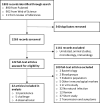Protection afforded by previous Vibrio cholerae infection against subsequent disease and infection: A review
- PMID: 34014927
- PMCID: PMC8136710
- DOI: 10.1371/journal.pntd.0009383
Protection afforded by previous Vibrio cholerae infection against subsequent disease and infection: A review
Abstract
Background: Cholera is an acute, diarrheal disease caused by Vibrio cholerae O1 or 139 that is associated with a high global burden.
Methods: We analyzed the estimated duration of immunity following cholera infection from available published studies. We searched PubMed and Web of Science for studies of the long-term immunity following cholera infection. We identified 22 eligible studies and categorized them as either observational, challenge, or serological.
Results: We found strong evidence of protection at 3 years after infection in observational and challenge studies. However, serological studies show that elevated humoral markers of potential correlates of protection returned to baseline within 1 year. Additionally, a subclinical cholera infection may confer lower protection than a clinical one, as suggested by 3 studies that found that, albeit with small sample sizes, most participants with a subclinical infection from an initial challenge with cholera had a symptomatic infection when rechallenged with a homologous biotype.
Conclusions: This review underscores the need to elucidate potential differences in the protection provided by clinical and subclinical cholera infections. Further, more studies are warranted to bridge the gap between the correlates of protection and cholera immunity. Understanding the duration of natural immunity to cholera can help guide control strategies and policy.
Conflict of interest statement
The authors have declared that no competing interests exist.
Figures




Similar articles
-
Memory B cell responses to Vibrio cholerae O1 lipopolysaccharide are associated with protection against infection from household contacts of patients with cholera in Bangladesh.Clin Vaccine Immunol. 2012 Jun;19(6):842-8. doi: 10.1128/CVI.00037-12. Epub 2012 Apr 18. Clin Vaccine Immunol. 2012. PMID: 22518009 Free PMC article.
-
Vibrio cholerae Sialidase-Specific Immune Responses Are Associated with Protection against Cholera.mSphere. 2021 Apr 28;6(2):e01232-20. doi: 10.1128/mSphere.01232-20. mSphere. 2021. PMID: 33910997 Free PMC article.
-
Immune responses to cholera in children.Expert Rev Anti Infect Ther. 2012 Apr;10(4):435-44. doi: 10.1586/eri.12.23. Expert Rev Anti Infect Ther. 2012. PMID: 22512753 Free PMC article. Review.
-
Induction of systemic, mucosal and memory antibody responses targeting Vibrio cholerae O1 O-specific polysaccharide (OSP) in adults following oral vaccination with an oral killed whole cell cholera vaccine in Bangladesh.PLoS Negl Trop Dis. 2019 Aug 1;13(8):e0007634. doi: 10.1371/journal.pntd.0007634. eCollection 2019 Aug. PLoS Negl Trop Dis. 2019. PMID: 31369553 Free PMC article.
-
Vibrio cholerae: lessons for mucosal vaccine design.Expert Rev Vaccines. 2011 Jan;10(1):79-94. doi: 10.1586/erv.10.150. Expert Rev Vaccines. 2011. PMID: 21162623 Free PMC article. Review.
Cited by
-
Estimating time-varying cholera transmission and oral cholera vaccine effectiveness in Haiti and Cameroon, 2021-2023.medRxiv [Preprint]. 2024 Aug 16:2024.06.12.24308792. doi: 10.1101/2024.06.12.24308792. medRxiv. 2024. PMID: 39185512 Free PMC article. Preprint.
-
Impact of a multi-pronged cholera intervention in an endemic setting.medRxiv [Preprint]. 2024 Sep 9:2023.12.14.23299970. doi: 10.1101/2023.12.14.23299970. medRxiv. 2024. Update in: PLoS Negl Trop Dis. 2025 Feb 19;19(2):e0012867. doi: 10.1371/journal.pntd.0012867. PMID: 39314953 Free PMC article. Updated. Preprint.
-
Modelling the impact of vaccination on cholera transmission dynamics under stratified populations and seasonality.Infect Dis Model. 2025 Jun 23;10(4):1138-1152. doi: 10.1016/j.idm.2025.06.006. eCollection 2025 Dec. Infect Dis Model. 2025. PMID: 40678793 Free PMC article.
-
Vibrio cholerae, classification, pathogenesis, immune response, and trends in vaccine development.Front Med (Lausanne). 2023 May 5;10:1155751. doi: 10.3389/fmed.2023.1155751. eCollection 2023. Front Med (Lausanne). 2023. PMID: 37215733 Free PMC article. Review.
-
Long-Term Kinetics of Serological Antibodies against Vibrio cholerae Following a Clinical Cholera Case: A Systematic Review and Meta-Analysis.Int J Environ Res Public Health. 2022 Jun 10;19(12):7141. doi: 10.3390/ijerph19127141. Int J Environ Res Public Health. 2022. PMID: 35742404 Free PMC article.
References
-
- World Health Organization. Cholera vaccines: WHO position paper–August 2017. Wkly Epidemiol Rec. 2017;92(34):477–98. - PubMed
-
- World Health Organization. Cholera [Internet]. 2019 [cited 2020 Nov 3]. Available from: https://www.who.int/news-room/fact-sheets/detail/cholera.
Publication types
MeSH terms
Substances
Grants and funding
LinkOut - more resources
Full Text Sources
Other Literature Sources
Medical
Miscellaneous

